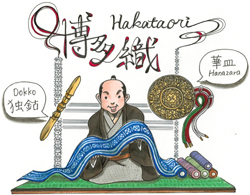Hakata Culture vol.69
Hakata-ori’s close associations with Buddhism

The Hakata-ori woven textile is a traditional Hakata craft as well known as the Hakata ningyo dolls. It has been popular for centuries for use in kimono and obi as a silk textile due to its tensility and thickness of the fabric. It makes a distinctive sound when pulled tight. This sound, called “kinunari” (sometimes referred to as “scroop” in English), is a hallmark of the finest silk.
Hakata-ori is closely connected to Buddhism. Mitsuda Yazaemon, a Hakata merchant who traveled to Sung dynasty China in the 13th century, returned with cloth weaving techniques that became the roots of Hakata-ori. Mitsuda consulted with the Zen monk Shoichi Kokushi to create the unique fabric. The monk had traveled with Mitsuda to China and established the Shoten-ji Buddhist temple in Hakata after he returned. Shoichi pointed to some Buddhist utensils, goes the story, and suggested he use the patterns as models for the design. The patterns on those utensils are still used today in Hakata-ori.
In the Edo period, Hakata-ori became an important gift presented to the Shogunate by the head of the Fukuoka domain. That’s the reason it’s sometimes called Kenjo Hakata. The cloth presented was in five colors: blue, red, navy blue, yellow, and purple. This gave rise to yet another name, Goshiki Kenjo. These five colors are said to represent the Wu Xing, or five phases, concept of China.
The Hakatamachiya Furusatokan, located next to the Kushida Shinto shrine, offers a demonstration of Hakata-ori weaving every day. Visitors to the Hakata Traditional Craft Center can also learn a lot about the material there. The Shoten-ji temple presents a type of trade show featuring Hakata-ori products every year early in November. This is an excellent opportunity to see the beautiful rock garden and buildings of the temple that are not ordinarily open to the public. There is a memorial tablet to Mitsuda Yazaemon on the temple grounds. Don’t miss this once-in-a-year chance!
仏教にゆかりの深い博多織
博多人形と並んで、博多の伝統工芸品として知られる博多織。生地に張りと厚みのある絹織物で、着物の帯として昔から人気があります。締めるときに「キュッキュッ」という独特の音がするのが特徴で、「絹鳴り」と呼ばれるこの音は良い絹織物にしかしないと言われています。
博多織は仏教にゆかりの深い織物です。13世紀に中国・宋へ渡った博多商人・満田弥三右衛門(みつだやざえもん)が、宋から持ち帰った織物の技法が博多織のルーツです。博多独自の織物を創るため、弥三右衛門は禅僧の聖一国師に相談します。聖一国師は弥三右衛門と一緒に宋に渡り、帰国後は博多に承天寺を開いていました。聖一国師はそばにあった仏教用具の独鈷と華皿を指して、これを図案化するよう提案したと伝えられています。独鈷と華皿は、現在でも博多織の代表的な図柄です。
江戸時代になると、博多織は福岡藩主から幕府への重要な献上品となります。そのため博多織は別名「献上博多」などと呼ばれることもあります。また幕府への献上品は青・赤・紺・黄・紫の5色とされていたため、「五色献上」と呼ばれることもあります。この五色は中国の五行説を色で表したものとされています。
櫛田神社そばの「博多町家」ふるさと館では毎日博多織の実演が行われています。また、はかた伝統工芸館では博多織について詳しく学べます。さらに毎年11月初旬には、承天寺にて博多織元の作品を集めた博多織求評会が開かれます。通常は内部を公開していない承天寺の美しい石庭や建物を楽しめる貴重な機会でもあり、境内には満田弥三右衛門の記念碑も建っています。ぜひこの機会に足を運んでみてください。

